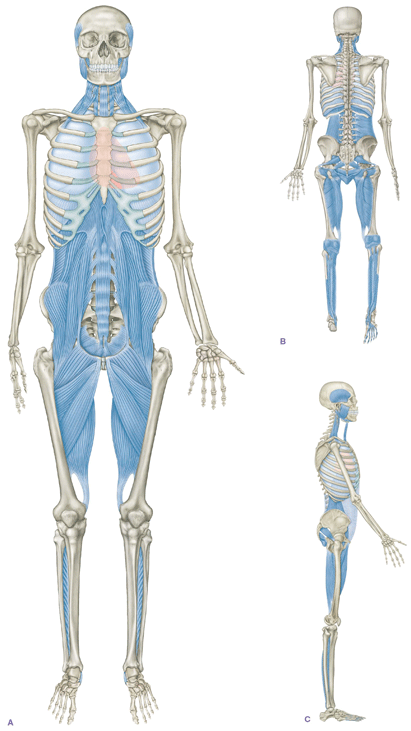Breathing, Rolling and Crawling
This past year I was exposed to my first PRI course, the SFMA, MovNat, Original Strength, and Dr. Anrdeo Spina’s Functional Range Conditioning. All 5 of these courses shared a common theme….
Learn to breathe. Learn to roll. Learn to crawl.
1. Breathing is the essence of life. You can go days without food, water, and sleep, but you can survive for only minutes without oxygen. You take 22,000 breaths per day. You read that right 22,000 breaths per day.
Thats 22,000 bad reps, if you’re doing it wrong, and there are not many people who get on my table who are doing it right. Imagine what your hips, knees, and spine would feel like if you did 22,000 bad squats per day? Just look at the fascial connections between the diaphragm and the rest of your muscles…

As you can see above poor breathing patterns could contribute to TMJ, a stiff neck, an immobile thoracic spine, a weak core, a tight low back, a compromised pelvic floor, stiff hips, shin splints, ect…. You get the idea.
2. Rolling and crawling are a crucial part of our neurological development. If someone misses either of these steps while they’re developing, serious movement and learning disabilities can occur. Before you stood up and took your first steps, you rolled and crawled around on the ground to develop all the small intrinsic muscles you need for locomotion.
“Developmentally, the proprioceptive system is intimately tied to the vestibular system that allows the balance necessary to move from an inert position. Babies begin moving from the core muscles, the inner muscles of the trunk. There is constant feedback from the proprioceptors to the motor cortex of the brain that allows more and more complexity of movement. So babies go from the belly wiggle, to rolling over, to sitting up, to standing up, and finally walking” – pg 49 Smart Moves by Carla Hannaford
“We have known for years that children who miss the vitally important crawling stage may exhibit learning difficulties later on. Crawling, a cross-lateral movement, activates development of the corpus callosum (the nerve pathway between the two hemispheres of the cerebrum). This gets both sides of the body working together, including the arms, legs, eyes (binocular vision) and the ears (binaural hearing). With equal stimulation, the senses more fully access the environment and both sides of the body can move in a more integrated way for more efficient action.” – Pg. 112 Smart Moves by Carla Hannaford
These are also the same small muscles that over time atrophy and cause all sorts of musculoskeletal pain and dysfunction. How do we lose our abilities to roll and crawl? Inactivity. As a society we lack movement. At age 7 most of us stop exploring our environment and schools confine us into those horrible things called chairs. Sitting is the new smoking of our generation. We sit an average of 9.3 hours a day. Thats 2.5 hours more then we sleep (6.7 hours)!
Remember: If you don’t use it, you lose it!
So how do we get it back? Here’s a good place to start:
- Breathing
- Rolling
- Crawling
- Train Movements, Not Muscles
- Lift Heavy Sh*t With Great Form (Don’t forget this one. It’s just as important as the first 4)
- Do Some Form of It Everyday
Do yourself a favor and educate yourself on the ins and outs of breathing, rolling, and crawling. See my favorite resources below. Although none of this stuff is new, it’s going to become more and more common place amongst trainers and clinicians over the next few years. So get on the Training = Rehab, Rehab = Training train now. If you don’t, the trains leaving the station without you.
My Favorite Resources:
Postural Restoration Institute – I use their breathing exercises almost exclusively. The detail and depth they go into anatomy is something I never got in undergrad or at massage school.
Dewey Neilson YouTube – Dewey has some of to coolest crawling and flow progressions on YouTube. Follow him.
Original strength – These guys came and did an entire in-service on ONLY those 3 things. Try to take a workshop if you can. Or sign up for BBB Online and watch it.
Move Nat – I love MovNat’s philosophy. I’d take their course again just for their manual. MovNat’s 13 “Movement Skills” are spot on. Their 4 day certification requires you to be proficient in both doing the movements and coaching those movements, and 90% of it is hands on.
Functional Range Conditioning – I was lucky enough to see Dr. Spina speak in the US for the first time. His stuff is going to take movement learning to the next level in the next year. You heard it hear first.
FMS & SFMA & Movement by Gray Cook – Your assessment means everything. If you a trainer or a clinician these are a must have in your tool box. “If your not assessing, you’re just guessing”
Start Moves by Carla Hannaford – Every trainer, teacher, and parent should read this book. It explains WHY things like breathing, crawling, rolling, and movement in general, have a huge impact on a child’s ability to learn and the way they behave.
2 Day Mobile Mentorships – Or you could always come and learn our interpretation of breathing, crawling, and rolling from us here at MBSC! We use this stuff daily with our athletes & adults in both group and private settings. Click the link to see if we’re coming to a city near you!
This article was written by Movement As Medicine co-owner and CFSC Coach Brendon Rearick. He can be contacted at brendonrearick@gmail.com